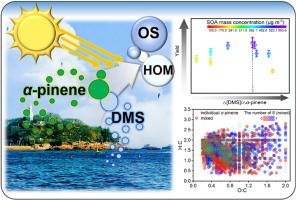Interaction between marine and terrestrial biogenic volatile organic compounds: Non-linear effect on secondary organic aerosol formation
IF 4.2
2区 环境科学与生态学
Q2 ENVIRONMENTAL SCIENCES
引用次数: 0
Abstract
Biogenic volatile organic compounds (BVOCs) are the largest source of secondary organic aerosols (SOA) globally. However, the complex interactions between marine and terrestrial BVOCs remain unclear, inhibiting our in-depth understanding of the SOA formation in the coastal areas and its environmental impacts. Here, we performed smog chamber experiments with mixed α-pinene (a typical monoterpene) and dimethyl sulfide (DMS, a typical marine emission BVOC) to investigate their possible interactions and subsequent SOA formation. It is found that DMS has a non-linear effect on SOA generation: The mass concentration and yield of SOA show increasing and then decreasing trends with the increase of the initial concentration of DMS. The increasing trend can be attributed to OH regeneration from isomerization of the CH3SCH2OO radical together with acid-catalyzed heterogeneous reactions by the oxidation of DMS, while the decreasing trend is explained by the less contribution of isomerization reaction and the high OH reactivity that inhibits the formation of low volatility products. The results from infrared spectra and mass spectra together reveal the contribution of sulfur-containing molecules in the mixed system. Moreover, the mass spectra results indicate that acidic products generated by DMS photooxidation enhance the O:C ratio, while organosulfates are produced to contribute to the formation of mixed SOA. In addition, the trends in relative abundance of highly oxygenated organic molecules (HOMs) with C8 - C10 multiple functional groups in different mixed systems agree well with the turning point of the SOA yield. The findings of this study have significant implications for understanding binary or more complex systems in the atmosphere in the coastal areas.

海洋和陆地生物挥发性有机化合物之间的相互作用:对二次有机气溶胶形成的非线性影响
生物挥发性有机化合物(BVOCs)是全球二次有机气溶胶(SOA)的最大来源。然而,海洋和陆地 BVOCs 之间复杂的相互作用仍不清楚,妨碍了我们深入了解沿海地区 SOA 的形成及其对环境的影响。在这里,我们用混合α-蒎烯(一种典型的单萜)和二甲基硫醚(DMS,一种典型的海洋排放 BVOC)进行了烟雾室实验,研究它们之间可能的相互作用以及随后 SOA 的形成。研究发现,DMS 对 SOA 的生成有非线性影响:随着 DMS 初始浓度的增加,SOA 的质量浓度和产量呈现先增加后减少的趋势。上升趋势可归因于 CH3SCH2OO 自由基的异构化以及 DMS 氧化作用下的酸催化异构反应产生的羟基再生,而下降趋势则可解释为异构化反应的贡献较小以及高羟基反应性抑制了低挥发性产物的形成。红外光谱和质谱结果共同揭示了混合体系中含硫分子的贡献。此外,质谱结果表明,二甲基亚砜光氧化反应产生的酸性产物提高了 O:C 比率,而有机硫酸盐的产生则促进了混合 SOA 的形成。此外,不同混合体系中具有 C8 - C10 多种官能团的高含氧有机分子(HOMs)的相对丰度趋势与 SOA 产量的转折点非常吻合。这项研究的结果对了解沿海地区大气中的二元或更复杂的系统具有重要意义。
本文章由计算机程序翻译,如有差异,请以英文原文为准。
求助全文
约1分钟内获得全文
求助全文
来源期刊

Atmospheric Environment
环境科学-环境科学
CiteScore
9.40
自引率
8.00%
发文量
458
审稿时长
53 days
期刊介绍:
Atmospheric Environment has an open access mirror journal Atmospheric Environment: X, sharing the same aims and scope, editorial team, submission system and rigorous peer review.
Atmospheric Environment is the international journal for scientists in different disciplines related to atmospheric composition and its impacts. The journal publishes scientific articles with atmospheric relevance of emissions and depositions of gaseous and particulate compounds, chemical processes and physical effects in the atmosphere, as well as impacts of the changing atmospheric composition on human health, air quality, climate change, and ecosystems.
 求助内容:
求助内容: 应助结果提醒方式:
应助结果提醒方式:


